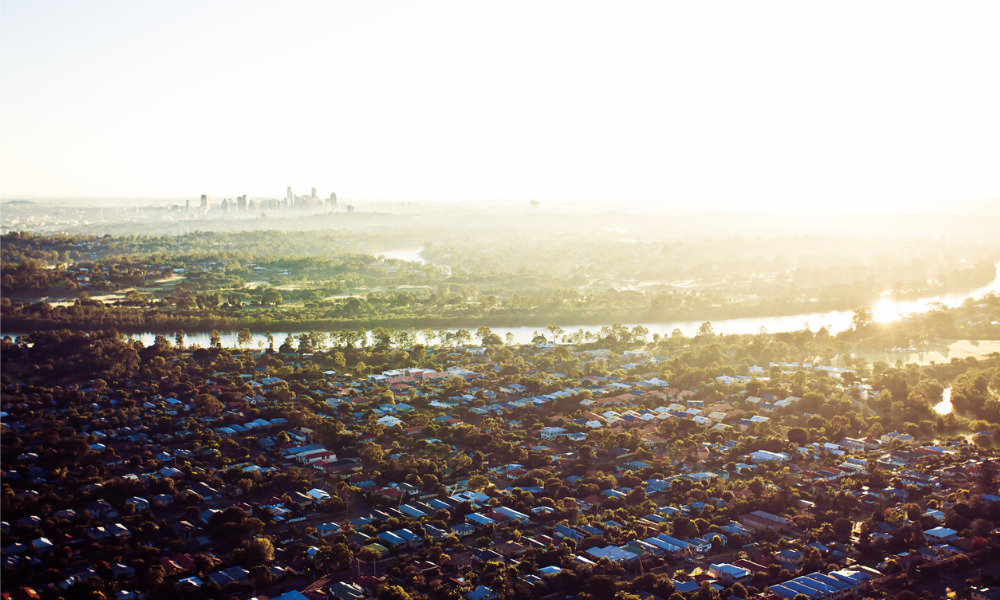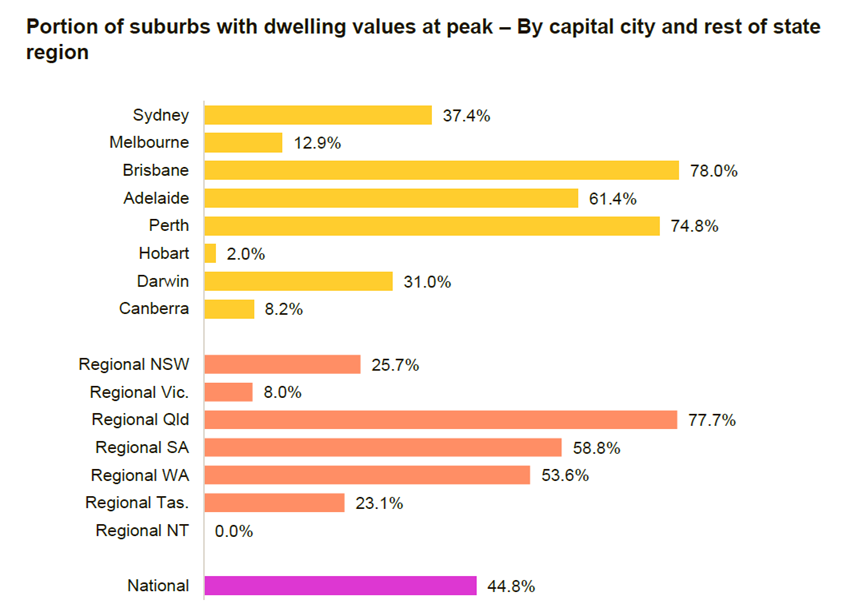Momentum builds with national values up 0.6% in June

Almost 45% of Australian suburbs have reached record-high home values, new housing data from property analytics firm Cotality shows.
The research, based on analysis of 3,722 suburbs, found that 44.8% had reached peak values by the end of June, with the number expected to grow further in coming months. The trend is strongest in Queensland and Western Australia, where several markets have already hit new highs.
Brisbane and regional Queensland led the surge, with 78.8% and 77.7% of suburbs at peak, respectively. Perth followed with 74.8%, while Adelaide (61.4%), regional South Australia (58.8%) and regional Western Australia (53.6%) also showed strength.
Cotality economist Kaytlin Ezzy noted that the suburb-level data shows the scope of the upturn. “While national indices provide a macro view, suburb-level data shows how widespread this growth phase really is,” she said.
“The fact that so many suburbs are either at or just shy of their peak shows not only the diverse recovery in markets like Sydney and Melbourne, but also the continued resilience of recent hotspots including Brisbane, Perth and Regional Australia.”
Cotality’s report shows that 329 suburbs were within 0.5% of their previous highs at the end of June, and 290 of those recorded growth during the quarter. With national home values rising 0.6% in June alone, the share of suburbs at record levels may soon surpass 50%.

Ezzy pointed out that market performance has varied across regions due to differing local conditions, including economic factors, housing supply, and migration. Cities like Sydney, Perth, Adelaide and Darwin have returned to their peaks, while others continue to recover.
“Across Melbourne, only 12.9% of suburbs saw record highs in June. In Canberra, only eight markets were at peak, while just one suburb (Brighton) recorded new highs in Hobart,” she said. “Despite home values trending higher though much of most of 2025, values across these broader regions remain -3.9%, -5.3% and -10.2% below their respective 2022 peaks.”
However, Ezzy (pictured below) noted that lower prices in these cities may offer opportunities for buyers. “While this might be received as bad news for homeowners, prospective buyers in these markets are in the position to access housing at prices lower than they were three years ago,” she said.

Darwin was among the strongest performers in the June quarter, with values hitting a new record high for the first time in 11 years. The market had been in decline for several years after the end of the mining boom, with prices falling 26.7% between 2014 and 2020.
“Market dynamics across Darwin’s housing market have undergone a remarkable transformation,” Ezzy said. “After years of subdued conditions following the end of the mining infrastructure boom, we’re now seeing demand and supply rebalancing in a way that supports further value growth.”
Cotality data shows investor interest in Darwin rose 98.2% over the year, while sales volumes jumped 44% and listings remained tight.
“Although unit values across the city remain below their previous highs, the broader dwelling market has firmly turned a corner,” Ezzy said.
Darwin also led quarterly growth among the capitals, with values increasing 4.9% in the three months to June. Perth and Brisbane followed, with gains of 2.1% and 2.0% respectively.
Total value of Australian homes hits $11.5 trillion
The report also indicated that the total value of Australian residential real estate held steady at $11.5 trillion at the end of June. National home values rose 1.4% over the second quarter, up from 0.9% in the previous quarter and reversing the 0.1% decline seen in the final three months of last year.
Over the 2024–25 financial year, values climbed 3.4%, the same growth rate recorded in the 12 months to May. With quarterly gains picking up pace, Cotality expects annual growth to gradually strengthen through the second half of 2025.
Regional markets continued to slightly outperform capital cities on a quarterly basis, rising 1.6% compared to 1.4% across the capitals. However, the monthly data showed stronger momentum in the cities during May and June, with growth of 0.6% versus 0.5% in the regions.
Cotality estimates there were 531,457 sales nationally in the 2024-25 financial year, a 2.7% increase from the previous year. However, homes are taking slightly longer to sell, with median days on market rising to 35 in the June quarter, up from 34 in the March quarter and 29 in the same period last year.
The volume of new listings remains low, with just 33,159 properties advertised for sale over the four weeks to 29 June – the lowest level for this time of year since 2020. The shortfall in fresh listings, combined with strong buyer activity, has pushed total stock levels 16.7% below the five-year average.
Rental growth also continued to moderate, with the national rental index rising 1.3% in the June quarter, the slowest second-quarter increase since 2020.
Want to be regularly updated with mortgage news and features? Get exclusive interviews, breaking news, and industry events in your inbox – subscribe to our FREE daily newsletter. You can also follow us on Facebook, X (formerly Twitter), and LinkedIn.



